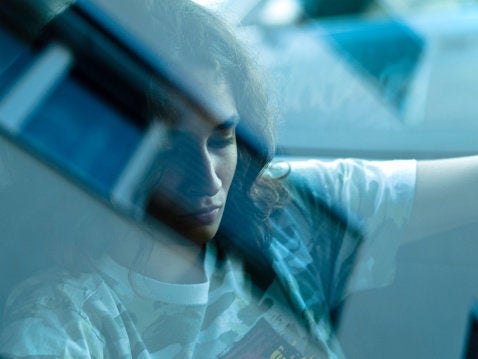A video that surfaced online this week appears to show a driver asleep at the wheel of a Tesla vehicle on autopilot mode -- and drivers everywhere collectively freaked out when they saw it.
With good reason. The electric carmaker has repeatedly said that its self-driving features don't make its cars completely autonomous, and that the driver should keep their hands on the wheel at all times and be ready to take over when necessary. Not to mention, it's extremely dangerous to get behind the wheel of a car if you're as tired as the person in this video apparently is.
Tesla currently offers autopilot features in its Model S and Model X cars, enabling the vehicles to steer themselves within a lane, change lanes with the driver’s tap of the turn signal, manage speed with a traffic-aware cruise control, parallel park upon command and find open parking spaces.
The company claims that digital control of motors, brakes and steering help its vehicles avoid collisions, as well as prevent the cars from running off the road.
But drivers still need to remain alert. On Wednesday, a video was posted to YouTube showing a Model S crashing into a van ahead of it. The Tesla owner claims not to have braked because they expected the autopilot features to react to the situation.
“We’re advising drivers to keep their hands on the wheel just in case.”
- Elon Musk, Tesla Chief Executive Officer
At a media event last year, Tesla Chief Executive Officer Elon Musk cautioned against relying too much on autopilot features.
“We’re being especially cautious at this stage, so we’re advising drivers to keep their hands on the wheel just in case,” Musk said. “We’re very clearly saying this is not a case of abdicating responsibility [for drivers].”
A spokesperson for the company on Thursday explained that the autopilot system is designed to alert the driver when it needs a human to take control of the vehicle. If the driver does not respond, the car begins to slow down until the driver does take over -- or it eventually comes to a complete stop and automatically engages the vehicle’s hazard lights, the spokesperson told The Huffington Post.
Autopilot "does not turn a Tesla into an autonomous vehicle," the rep added.
Policies and legislation on automated vehicles are still catching up with the technology. While the National Highway Traffic Safety Administration was not able to comment on the video, the agency's communications director, Bryan Thomas, told HuffPost that NHTSA is in the process of developing autonomous vehicle guidelines. The department is expected to issue the rules this summer.
Meanwhile, legislation on drowsy driving is also in the process of catching up, though there is already pretty clear data on the dangers of driving while sleepy.
Drowsy drivers involved in a crash were found to be twice as likely to have made performance errors compared to drivers who were not fatigued, according to data from the NHTSA's National Motor Vehicle Crash Causation Study. The NHTSA estimates 83,000 crashes each year are related to drowsy driving. Other estimates say it's as high as 1.2 million per year.
Sarah DiGiulio is The Huffington Post’s sleep reporter. You can contact her at sarah.digiulio@huffingtonpost.com.

